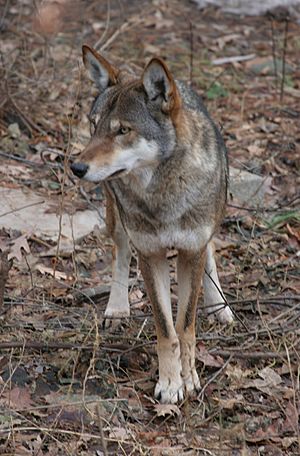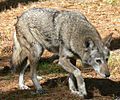Red wolf facts for kids
Quick facts for kids Red wolfTemporal range: Holocene 10,000 years ago – present
|
|
|---|---|
 |
|
| A red wolf showing typical coloration | |
| Conservation status | |
| Scientific classification | |
| Genus: |
Canis
|
| Species: |
rufus
|
| Subspecies | |
|
|
The red wolf (Canis rufus) is a wild dog that lives in the southeastern United States. It's bigger than a coyote but smaller than a gray wolf.
The red wolf is an endangered species. This means there are very few of them left. The U.S. Fish and Wildlife Service protects them. The IUCN also lists them as a Critically Endangered species. This is the highest risk category for animals in the wild.
Contents
Red Wolf History
Red wolves used to live across a large area of the southeastern and south-central United States. Their home stretched from the Atlantic Ocean all the way to central Texas. They were also found in parts of Oklahoma, Illinois, and even southern Ontario in Canada.
By the mid-1900s, the red wolf was almost gone. This happened because people hunted them, their homes were destroyed, and they bred with coyotes. By the late 1960s, only a few red wolves were left in western Louisiana and eastern Texas.
To save the species, the Point Defiance Zoo & Aquarium started a special program. Between 1974 and 1980, they gathered fourteen of the last red wolves. Their goal was to breed them safely in captivity. This way, they hoped to increase their numbers and release them back into the wild. In 1980, the red wolf was declared extinct in the wild. This meant there were no red wolves left living freely outside of zoos.
Red Wolves and Humans
For a long time, red wolves have been important to the Cherokee people. They call the red wolf wa'ya (ᏩᏯ). In their beliefs, the red wolf is a friend of Kana'ti, who is a hunter and the father of the Aniwaya, or Wolf Clan. Traditionally, Cherokee people do not kill red wolves. They believe that doing so would make the wolf's pack angry and bring bad luck.
What Red Wolves Look Like
Red wolves are medium-sized canines. They are larger than coyotes but smaller than gray wolves. Adult red wolves are about 53.5 to 63 inches (136–160 cm) long. They weigh between 50 and 85 pounds (23–39 kg).
Their fur is usually more reddish than that of coyotes or gray wolves. It can be orange-brown, yellow-brown, or grayish. They often have lighter fur around their lips and eyes.
Red Wolf Behavior
Red wolves are more social than coyotes, but not as social as gray wolves. They usually live in small family groups.
Reproduction and Life Cycle
Red wolves are monogamous, meaning they stay with the same partner for life. They mate in January or February. On average, a mother red wolf gives birth to 6 or 7 pups in March, April, or May.
Both parents help raise the young pups. Their dens are often found in hollow tree trunks, along stream banks, or in old burrows dug by other animals. By the time they are six weeks old, the pups start to explore away from the den. They reach their full size when they are about one year old. They are ready to have their own pups two years later.
What Red Wolves Eat
Before they became extinct in the wild, red wolves mainly ate small animals like rabbits, rodents, and nutria. Nutria are a type of large rodent that were brought to the United States from other places.
Red wolves that have been released back into the wild today eat different foods. Their diet now includes white-tailed deer, raccoons, nutria, and rabbits.
Where Red Wolves Live
The red wolf used to live across the entire southeastern United States. This included areas from the Atlantic and Gulf Coasts, north to the Ohio River Valley, and west to Central Texas.
Red wolves probably lived in many different types of places. The last wild red wolves lived in coastal marshes, swamps, and farm fields. However, scientists believe that red wolves originally lived mostly in forests along rivers and in swamps. These areas were later cleared by humans.
Reintroduced Habitats
Since 1987, red wolves have been released into northeastern North Carolina. They now roam across 1.7 million acres of land there. More than half of this land is private property. About 680,000 acres (2,750 km2) are federal and state lands, and 1,002,000 acres (4,055 km2) are private lands.
There was an attempt to bring red wolves back to the Great Smoky Mountains National Park, but it didn't work out. The remaining red wolves from that effort were moved to the Alligator River National Wildlife Refuge in eastern North Carolina. Other red wolves have been released on islands off the coasts of Florida, Mississippi, and South Carolina. This is part of the plan to manage the captive breeding program.
Saving the Red Wolf

After the Endangered Species Act of 1973 was passed, the U.S. Fish and Wildlife Service (USFWS) started a program to save the red wolf. They captured four hundred wolves and brought them to the Point Defiance Zoo & Aquarium in Washington. They tested these animals to find the ones that were pure red wolves. Only fourteen wolves were chosen to be the parents for the captive breeding program.
Red Wolf Status in the 1900s
In 1996, the International Union for Conservation of Nature (IUCN) officially listed the red wolf as a critically endangered species. This means it was, and still is, at a very high risk of becoming extinct in the wild.
Red Wolf Status Today
Today, more than 30 zoos and wildlife centers are part of the Red Wolf Species Survival Plan. They help with breeding and reintroducing over 150 wolves.
In 2007, the USFWS thought there were about 300 red wolves in the world. About 207 of these were in captivity. Since then, the numbers have gone down. This is partly because some landowners kill wolves, and the USFWS has not been as active in protecting them.
In the winter of 2021-2022, a family of five red wolves was released into the Pocosin Lakes National Wildlife Refuge. Also, two new pairs of adult wolves were released into the Alligator River National Wildlife Refuge. These new releases brought the number of wild red wolves in eastern North Carolina to less than 30.
On April 22, 2022, one of the new breeding pairs had six pups! There were four females and two males. This was the first litter of red wolf pups born in the wild since 2018, which was very exciting news for conservation efforts.
Cool Facts About Red Wolves
- There has never been a recorded case of a red wolf attacking a person. The story of Little Red Riding Hood is just a fairy tale!
- Red wolves don't just eat meat; they also enjoy berries.
- Red wolves help the plants in wetlands by eating nutria. Nutria are large rodents that eat a lot of wetland plants.
- Red wolves usually stay with the same partner for their whole lives.
- Sometimes, a red wolf couple will even help care for other red wolf pups.
- Red wolves can run very fast, up to 30 miles per hour, for short times when they are chasing food.
- They have been known to travel up to 20 miles in one day while looking for food.
- Red wolves eat about 2 to 5 pounds (0.9–2.3 kg) of food each day.
- Red wolves talk to each other using different sounds, like howling. They also use their body movements, facial expressions, and even scent marking to communicate.
Images for kids
-
Comparative image of a red wolf and a western coyote (C. latrans incolatus)
-
Melanistic red wolf at Audubon Park, New Orleans (1931)
See also
 In Spanish: Lobo Rojo para niños
In Spanish: Lobo Rojo para niños
















